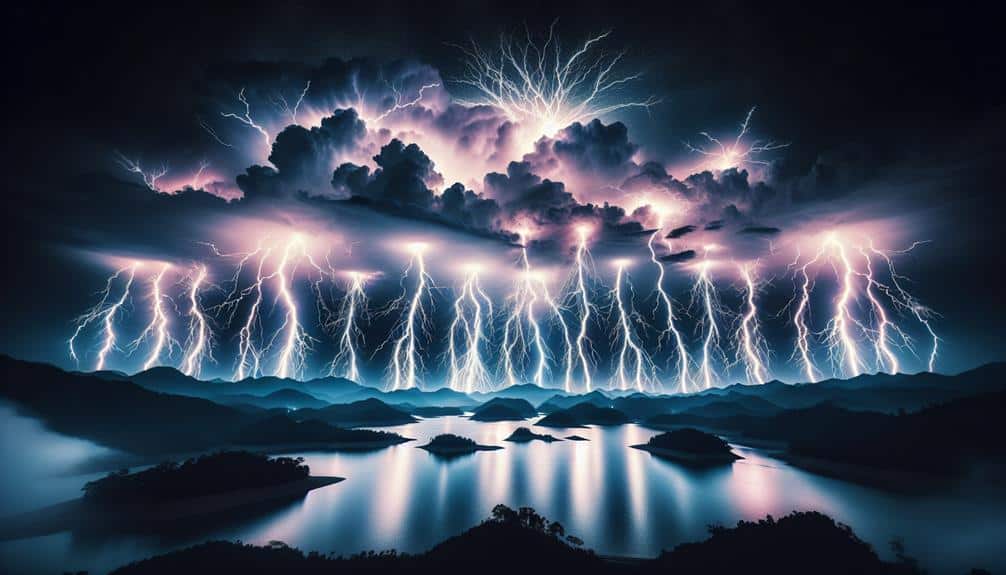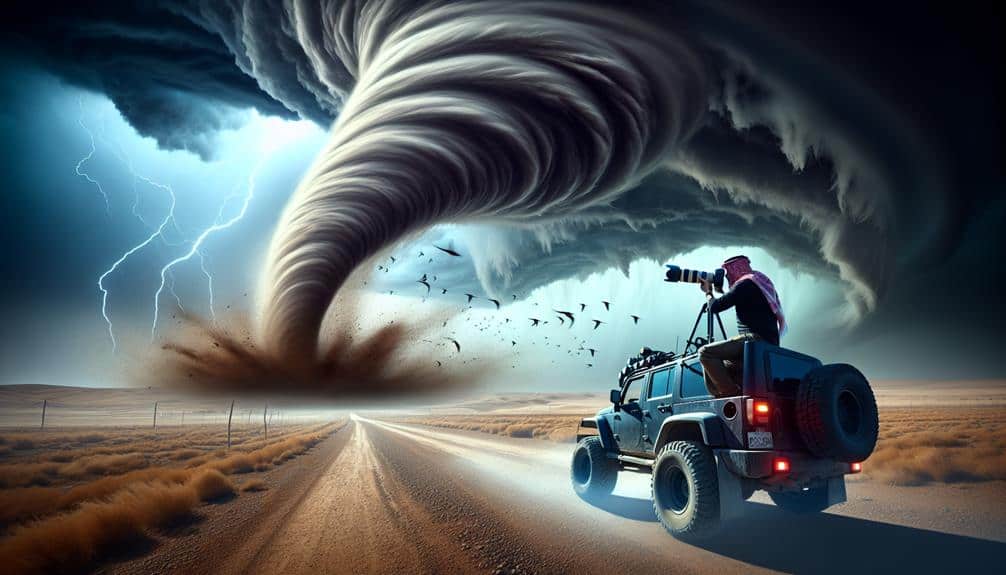We can showcase the sheer impact of blizzards by combining our photography talent with the right techniques and gear. Prioritizing durable, weather-resistant equipment guarantees our cameras and lenses withstand harsh conditions. Capturing the dynamics of swirling snow and atmospheric lighting creates impactful images, while timely shooting at dawn or dusk provides ideal lighting. Post-processing helps highlight textures and colors, giving our photos a vibrant, compelling quality. Safety is critical; we need emergency kits and reliable communication at all times. By honing these skills, we're able to convey nature's awe-inspiring power through our lens, revealing more as we go.
Key Points
- Capture dynamic snow interactions: Photograph swirling snow against the landscape to highlight the blizzard's intensity and movement.
- Leverage atmospheric lighting: Utilize natural lighting in early mornings and late afternoons to enhance the mood and drama of snowstorms.
- Emphasize textures and details: Focus on the unique textures and intricate details of snow accumulation to showcase the blizzard's impact.
- Experiment with perspectives: Shoot from various angles to find creative compositions that capture the blizzard's unique aspects and effects on the environment.
Choosing the Right Gear
Selecting the appropriate gear for photographing blizzards is vital to capturing the raw beauty and intensity of these natural events. We must prioritize durability and weather resistance when choosing our equipment. Investing in high-quality gear doesn't mean we've to break the bank; careful budgeting and smart choices can keep costs manageable without compromising performance.
Gear maintenance is important in harsh conditions. Making sure our cameras and lenses are well-sealed against moisture and cold will prolong their lifespan and maintain their functionality. Regular cleaning and using protective covers can help safeguard our investments.
When it comes to brand comparisons, we should consider the reliability and features offered by each. Canon and Nikon offer robust models with excellent weather sealing, while Sony's mirrorless options provide portability and advanced technology. Each brand has its strengths, and our choice should align with our specific needs.
Lens options are another significant consideration. Wide-angle lenses are ideal for capturing expansive snow-covered landscapes, while telephoto lenses excel in isolating subjects amidst the storm. Balancing our lens choices with our overall budget ensures we're prepared for various shooting scenarios.
Ultimately, selecting the right gear sets the foundation for our journey into blizzard photography.
Capturing Blizzard Dynamics
To truly capture the dynamics of a blizzard, we need to understand how to convey its movement and intensity through our photography. Blizzard photography challenges us to work with fast-changing conditions and limited visibility, but this also opens the door for creative compositions. By embracing the extreme weather, we can highlight the raw power and beauty of blizzards.
When capturing blizzard beauty, it's essential to focus on the swirling snow and how it interacts with the landscape. Using slower shutter speeds can create a sense of motion, while faster speeds can freeze individual snowflakes in mid-air. Atmospheric lighting plays a significant role here; the diffused light during a blizzard can create a soft, almost ethereal effect that enhances the overall mood of the photograph.
We can also experiment with different angles and perspectives to showcase the depth and scale of the storm. Shooting through windows or framing shots with natural elements like trees or buildings can add layers to our images.
Timing and Location Strategies
Timing and location are crucial elements that often dictate the success of our blizzard photography endeavors. To capture the raw beauty and intensity of a blizzard, we must rely on accurate weather forecasting. By closely monitoring weather reports, we can anticipate when and where the blizzard will hit, allowing us to make precise travel plans. This proactive approach ensures we're at the right place at the right time, ready to seize the moment.
Once on location, the choice of angles and lighting opportunities becomes vital. Snowstorms can transform ordinary landscapes into mesmerizing scenes, but it's up to us to find those creative angles that highlight their unique aspects. Whether shooting through the swirling snow or capturing the soft glow of streetlights through the flurry, our perspective can turn a simple snowstorm into an unforgettable image.
Moreover, considering the time of day can significantly impact our results. Early morning and late afternoon provide golden lighting opportunities, enhancing the dramatic effect of the blizzard.
In the end, our attention to timing and location not only boosts our chances of capturing stunning photos but also grants us the freedom to explore and document nature's awe-inspiring events.
Post-Processing Techniques
Having captured the blizzard's mesmerizing moments, we now turn our attention to post-processing techniques that will bring out the full potential of our photographs. Through careful editing, we can enhance the raw beauty of nature's wrath and create compelling visuals that resonate with viewers.
First, we start with color correction. Adjusting the white balance can eliminate any color casts caused by snow reflections, while enhancement techniques like increasing contrast and saturation can make the colors pop, giving our images a more vibrant appearance.
Next, we explore texture manipulation. Blizzards often create intricate patterns in the snow and ice. By accentuating these textures through sharpening and clarity adjustments, we can highlight the unique details that make each photograph stand out. Creative filters can also add an artistic touch, transforming a simple scene into something extraordinary.
Lastly, let's talk about creative filters. Filters can significantly alter the mood of our images. Whether we want to evoke a sense of cold isolation or vibrant energy, filters help us achieve our desired effect.
- Color correction: Adjust white balance, contrast, and saturation.
- Texture manipulation: Sharpen and enhance details.
Safety Tips for Storm Chasers

Storm chasing can be exhilarating, but prioritizing safety is essential to capturing stunning images without putting ourselves in harm's way.
First, let's focus on emergency preparedness. We should always carry a well-stocked emergency kit, including essentials like first aid supplies, food, water, and extra clothing. Reliable communication is key; having a fully charged phone and backup battery ensures we can stay connected.
Vehicle maintenance is another crucial aspect. Before heading out, we need to check our vehicle's tires, brakes, and battery. A full tank of gas and spare tire can be lifesavers when maneuvering through unpredictable weather. Regular maintenance keeps our vehicle ready for any conditions we might face.
Keeping ourselves updated on weather conditions is vital. Monitoring weather updates from trusted sources helps us make informed decisions about when and where to chase. Apps and radios designed for storm chasers can provide real-time data, giving us the edge we need to stay safe.
Frequently Asked Questions
How Can Photographers Protect Their Equipment From Extreme Cold During a Blizzard?
We can protect our equipment from extreme cold by using insulating gear and keeping our batteries warm. Insulated camera bags and hand warmers are essential for maintaining battery life and preventing damage to our gear.
What Are the Best Ways to Keep Camera Batteries From Draining Quickly in Cold Weather?
When winter's chill grips our cameras, we shield the heart. For winter photography techniques, let's keep spare batteries warm in our pockets, minimize LCD use, and switch off non-essential features. These cold weather battery saving tips help greatly.
How Can One Capture the Emotional Impact of a Blizzard on Communities?
We can capture the emotional impact of a blizzard on communities by focusing on winter landscapes and the blizzard aftermath. Highlighting community resilience and capturing emotions in these moments truly showcases the strength and spirit of people.
Are There Any Famous Photographers Known for Their Blizzard Photography?
Isn't it ironic that Ansel Adams, known for landscapes, and Art Wolfe, who captures nature's essence, aren't famous for blizzard photography? Yet, their work still captures emotions and community impact, resonating with our desire for freedom.
How Do Blizzards Affect the Visual Storytelling in Photography?
Blizzards enhance our visual storytelling by creating unique blizzard aesthetics. The atmospheric conditions challenge us to use inventive photography techniques, capturing the raw power and beauty of nature, making each shot compelling and evocative.


